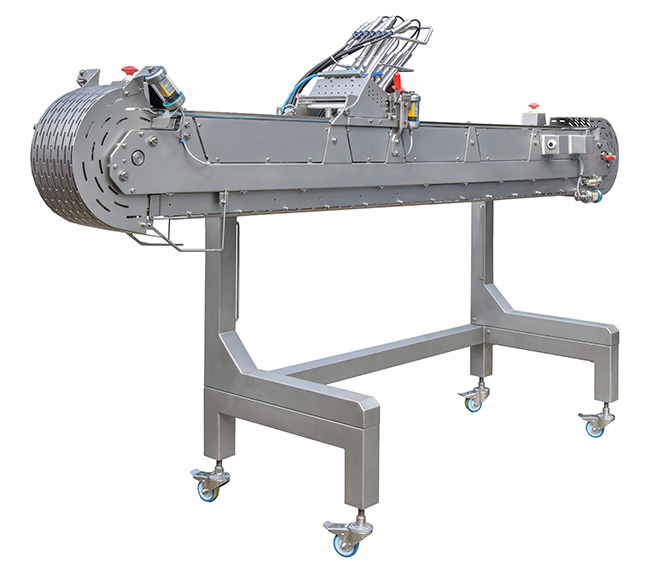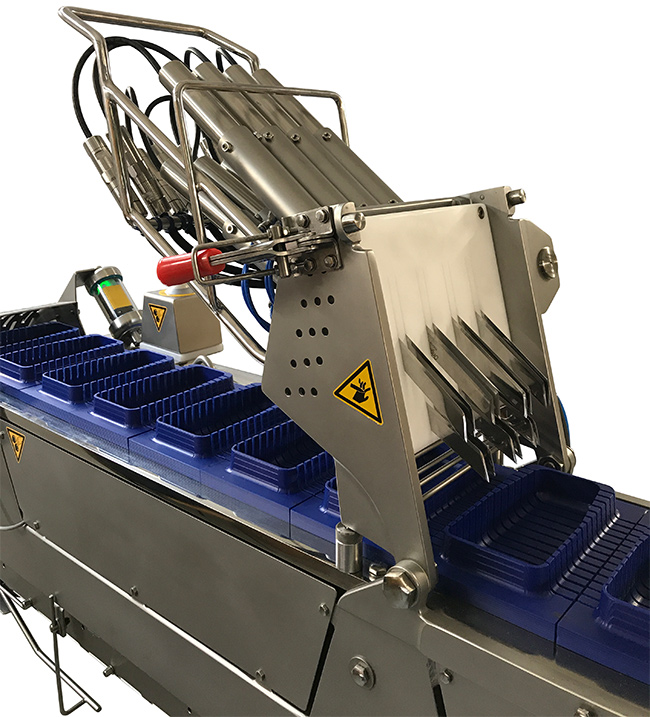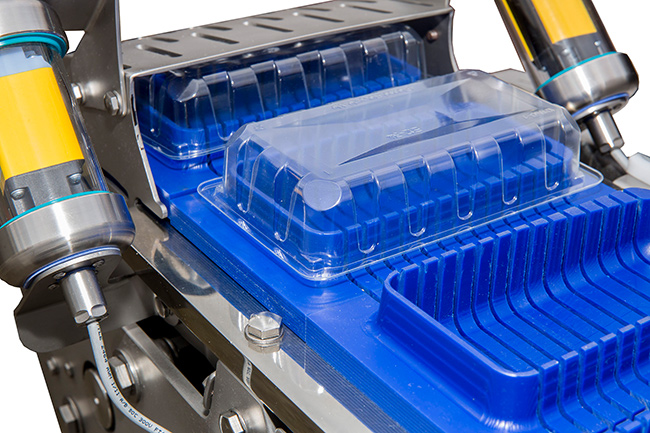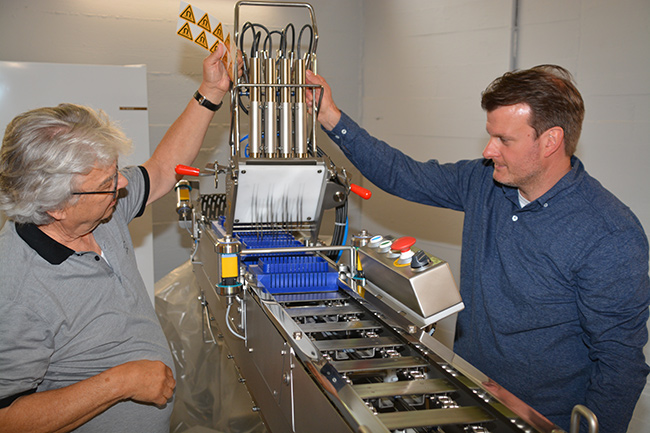IFFA 2022 Preview: Vertical Slicer for Roast Meat Products – Automation has never been able to retain the natural shape of roasted poultry breast filets when cutting this high-quality product into thin slices. Food Technology Thielemann, which specializes in poultry slicers, has introduced the world’s first solution for this task. Using lean, hygienic linear motors made of stainless steel from LinMot, the high-output vertical slicer has been kept simple in design for high energy efficiency and performance.

“It is nearly impossible to cut up a hard-boiled egg with a single blade while keeping its shape,” says Ulrich Thielemann, founder of Food Technology Thielemann GmbH & Co. KG. “With an egg slicer, however, it’s no problem whatsoever.”
This little kitchen gadget became the inspiration for developing the latest machine from the sales and design specialist for high-performance machinery for processing poultry breast filets. The same way an egg is held in the pocket of the egg slicer, the chicken breast filet to be cut up is placed in a product carrier with slits for the cutting blades. This is used to transport the meat along a conveyor chain to the cutting unit. In contrast to the egg slicer, however, 14 oscillating blades are used instead of wires to cut the meat. Once it leaves the conveyor, the product carrier is covered with a packaging tray, flipped over, and fed into a packaging machine to be sealed. This sequence ensures that the natural shape of the poultry breast remains intact while it is cut up and packaged, up to the point of consumption.

Fourteen blades, driven by seven linear motors, are the core of the cutting unit (folded up here). (Foto: Thielemann)
Conventional vertical slicers are not up to the job
“Meat is typically cut into strips by a vertical slicer, which produces the packaged portions that you find every supermarket. These machines are equipped with circular, sickle-shaped, or oscillating blades, but are not suitable for this purpose,” explains Thielemann. Even when used in conjunction with a product carrier, where the product to be cut rests in a recess, they are not up to the task, as the meat-processing expert explains: “You need 14 blades acting in parallel to cut 10 mm thick slices from a filet that averages 160 mm in length. With circular blades, which are at least 2.5 mm thick, the total displacement would be 35 mm. The meat would get stuck between the blades or torn to bits.”

Product carrier with a recess in the shape of the product to be cut, to retain the original shape of the product. (Foto: Thielemann)
Combination of shape and oscillating blades
For this reason, Thielemann finds that oscillating blades that use a cutting motion like a jigsaw produce the best quality cut. The necessary linear motion can be generated in a variety of ways. Traditionally, linear motions in machines with oscillating blades have been produced by rotary motors with eccentric discs or camshafts. “We are always working on ways to optimize our machines, and this includes making them simpler and more robust,” adds Thielemann. “I pictured a drive solution that would produce a linear motion without a mechanical transmission.”
For the prototypes, the designer had intended to use pneumatic motors, but discarded them for the initial launch due to their disadvantages. “We were able to produce the necessary linear motion with these drives, but the noise emissions of over 90 dB and compressed air consumption of up to 250 liters per minute, per blade, were simply much too high.”
The machine builder’s interest was piqued in the fall of 2020 when LinMot introduced its new line of SSCP motors dedicated for use in the food products and pharmaceutical industries. They are made of 1.4404 stainless steel (AISI 316L), meet protection class IP69, and use FDA-approved polymer bearings.

Founder Ulrich Thielemann and sales specialist Michael Glaser put the finishing touches on the new vertical slicer prior to shipping to the first customer. (Foto: Thielemann)
Simple machine design with lean linear motors
The new motors include the variant PS01-23x160H-HP-SSCP-R20 (stator), which Thielemann selected for his new machine due to its extremely narrow form factor and high drive force. A total of seven linear motors are mounted in two offset rows above the product level. “Their small diameter of 28 mm made it possible to position the motors so close together that we get 10 mm thick slices without any sort of linkage,” says the company’s founder. There was even enough space to mount the motors in an enclosing metal tube.
This was possible, however, only because the nominal force of the motor, at 21.5 N, and the maximum drive force of 138 N were sufficient to allow two blades to be mounted on each of the model PL01-12×230/190-HP-W01 high-performance sliders.
The SSCP stainless steel linear motors are not only extremely compact and powerful, but also have excellent thermal properties. Thielemann was therefore able to use a simple air-cooling system for the machine. “Because there is no space for conventional heat sinks, we pump compressed air at 0.5 bar through the installation tube that partially encloses the motors. This is sufficient to keep the motors reliably below 60 degrees Celsius during continuous operation, at the typical ambient temperature of about 5 degrees in meat-processing plants.

Optimal application for linear motors: servocontrollers with integrated safety, and power supply modules from LinMot. (Foto: Rossmann)
60 filets per minute
The overall output of the machine is easy to see: with 20 cutting strokes, at 8 mm per second, the machine produces 3,600 filets an hour. “This puts us in the highest output category for slicers. The motors would be able to reach even higher cutting speeds, but the handling of the filets and the upstream and downstream processes, such as packaging, set the actual limits here,” says Thielemann.
The motors are actuated by seven model C1100-GP servocontrollers with integrated STO function (Safe Torque Off). A separate controller with user interface is not currently planned. The drive parameters were set by LinMot engineers, working closely with Thielemann, who praises the quality of service. “The support was exemplary, just as it had been on a previous project, and we were able to work together outstandingly, even in Corona times.”
The machine was designed and built in just a few months. The first user of the machine is a poultry processor from the United Kingdom. The company, which gave the initial impetus for developing the machine, has now expanded its offerings of finished products to include a high-quality, organic convenience product that was previously impossible to produce.
The positioning of the machine is evident here: cutting roasted products for finished goods in the delicatessen field. Thielemann is convinced that the market potential for the new machine is just as great. “The number of potential applications is practically limitless. The trend toward high-quality convenience products is continuing. This works to our benefit.” The company has made the machine the focal point of its appearance at the IFFA 2022 trade show.
You are currently viewing a placeholder content from Yumpu. To access the actual content, click the button below. Please note that doing so will share data with third-party providers.
More Information